Introduction
The Red Fort Delhi India, popularly known as Lal Qila, is one of the most iconic landmarks in the country. Situated in the heart of Old Delhi along the banks of the Yamuna River, this magnificent fort is a UNESCO World Heritage Site and a timeless reminder of India’s royal past. Commissioned in the 17th century by the Mughal emperor Shah Jahan, the fort was designed as the centerpiece of his new capital, Agra Fort, now known as Shahjahanabad.
Today, the Red Fort in Delhi stands not only as an architectural masterpiece but also as a symbol of Indian independence and national pride. Each year on August 15th, the Prime Minister of India hoists the national flag from the Lahori Gate and addresses the nation, a tradition that began with Jawaharlal Nehru’s historic speech in 1947. Its political, cultural, and historical significance make it one of the most visited heritage attractions in the country.
Red Fort Delhi History
Origins under the Mughal Emperor Shah Jahan
The story of Red Fort Delhi began in 1638, when Emperor Shah Jahan decided to move his Mughal capital from Agra to Delhi. To reflect the might and sophistication of his empire, he envisioned a grand new walled city called Shahjahanabad. At its very core, he commissioned a royal fortress that would later be known as the Red Fort.
Construction and Architecture (1638–1648)
The construction lasted a full decade and was completed in 1648 under the supervision of Ustad Ahmad Lahauri, the chief architect of the Taj Mahal. Built primarily with red sandstone, the fort stretches across nearly 254 acres, with defensive walls rising as high as 33 meters. The layout is a brilliant combination of strong military defenses and refined aesthetics, featuring massive gates, wide moats, and elegant palaces.
The Mughal Era – Red Fort at Its Peak
During the Mughal era, the Red Fort in Delhi served as the royal residence and a thriving hub of culture, politics, and administration. The emperor addressed his subjects in the Diwan-i-Aam (Hall of Public Audience) and met foreign dignitaries in the Diwan-i-Khas (Hall of Private Audience). The legendary Peacock Throne, encrusted with precious jewels, once stood here before being looted by invaders. Festivals, royal ceremonies, and state functions held within the fort reflected the grandeur and influence of Mughal rule.
Colonial Period and British Occupation
The decline of the Mughal dynasty in the 18th century marked a turning point for the fort. Following the Revolt of 1857, the British seized control of the Red Fort in Delhi and repurposed much of the complex for military use. Several Mughal structures were demolished to make way for barracks and offices. Despite these losses, prominent sections such as the Lahori Gate, Rang Mahal, Diwan-i-Aam, and Khas Mahal survived and remain major attractions today.
Red Fort in Independent India
On 15th August 1947, when India gained independence, Jawaharlal Nehru delivered his historic address to the nation from the ramparts of the Red Fort, marking the birth of a free India. Since then, the fort has become a national symbol, hosting the annual Independence Day flag-hoisting ceremony. Today, it welcomes millions of visitors every year and continues to represent India’s resilience, unity, and cultural pride.
Architectural Marvels of Red Fort
Layout of the Fort Complex
The design of the Red Fort in Delhi perfectly blends military strength with artistic elegance. Built in a vast rectangular layout, the fort is surrounded by towering walls, massive bastions, and a wide defensive moat, making it nearly impenetrable in its time. The two main entry points—the Lahori Gate and the Delhi Gate—were not only gateways but also symbols of Mughal authority and grandeur.
Inside, the fort feels like a miniature city. It is carefully planned with palaces, audience halls, gardens, mosques, and royal residences, reflecting the Mughal vision of creating a self-sufficient imperial complex. Every section of the fort combines functionality with architectural sophistication.
Famous Structures Inside the Red Fort
-
Diwan-i-Aam (Hall of Public Audience):
-
This large hall, supported by elegant arches, was where the emperor addressed the public and heard their petitions. It reflected the Mughal ruler’s role as both a monarch and a judge.
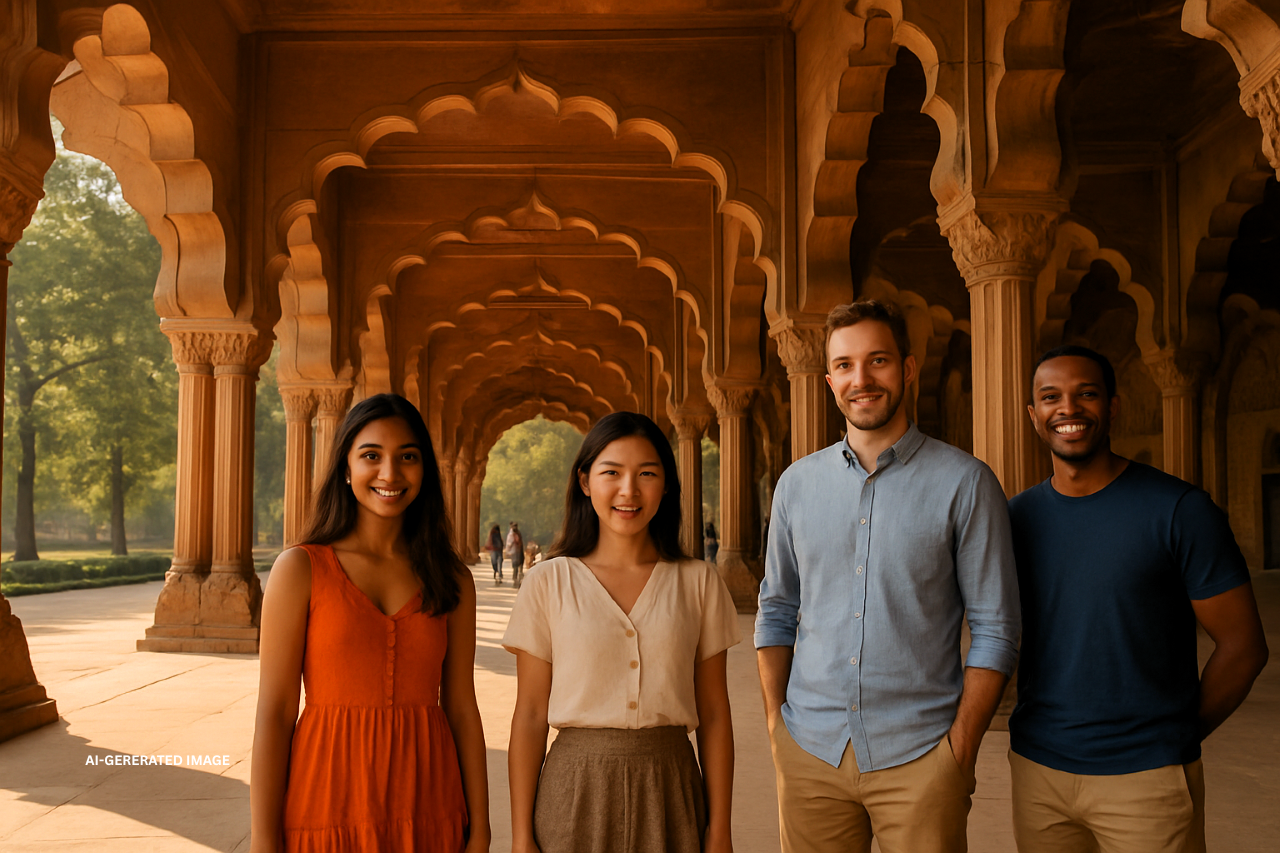
-
Diwan-i-Khas (Hall of Private Audience):
-
Reserved for meetings with nobles and dignitaries, this hall is celebrated for its intricate design and luxurious interiors. It once housed the legendary Peacock Throne, adorned with precious gems, symbolizing Mughal wealth and authority.
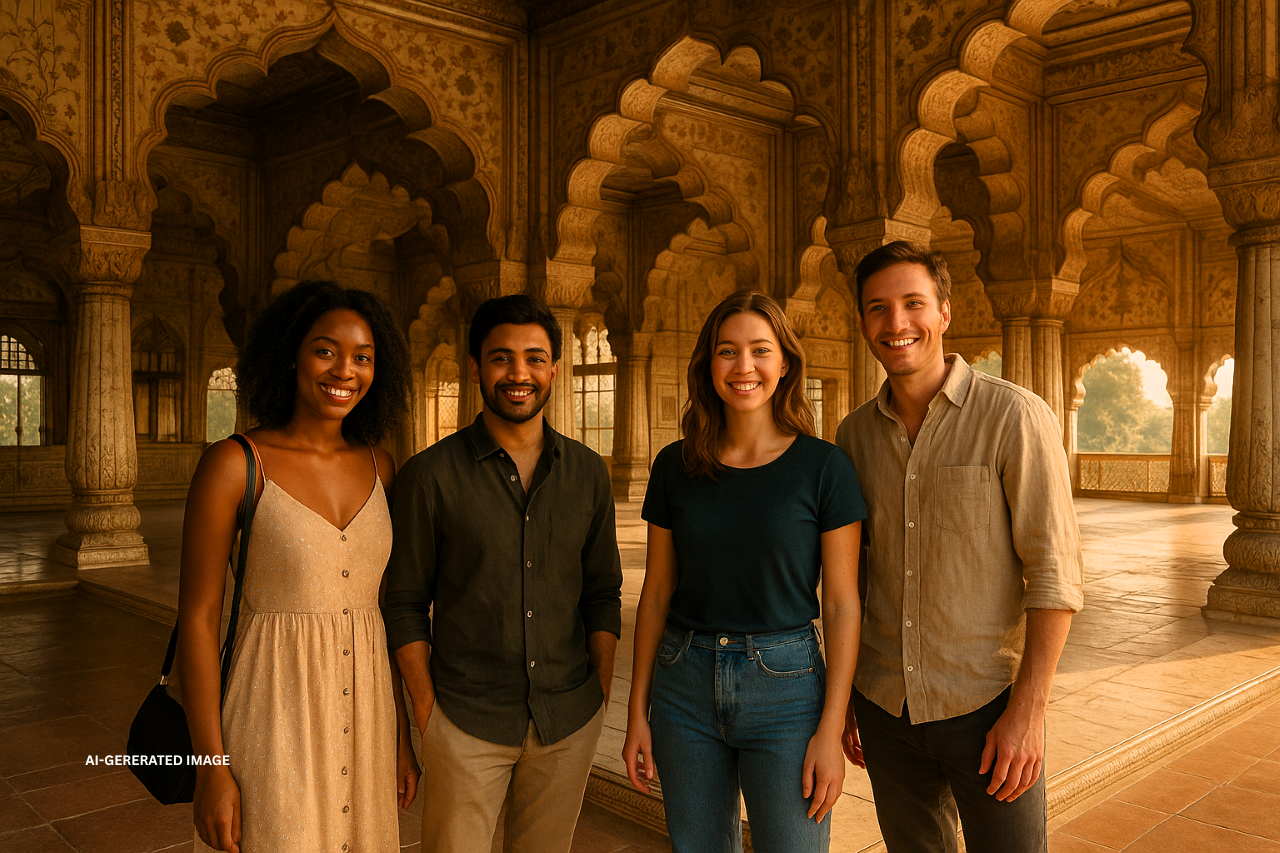
-
Rang Mahal (Palace of Colors):
-
A beautifully decorated palace that served as the living quarters for royal women. Its painted ceilings, mirror work, and flowing water channels made it a vibrant and refreshing retreat.
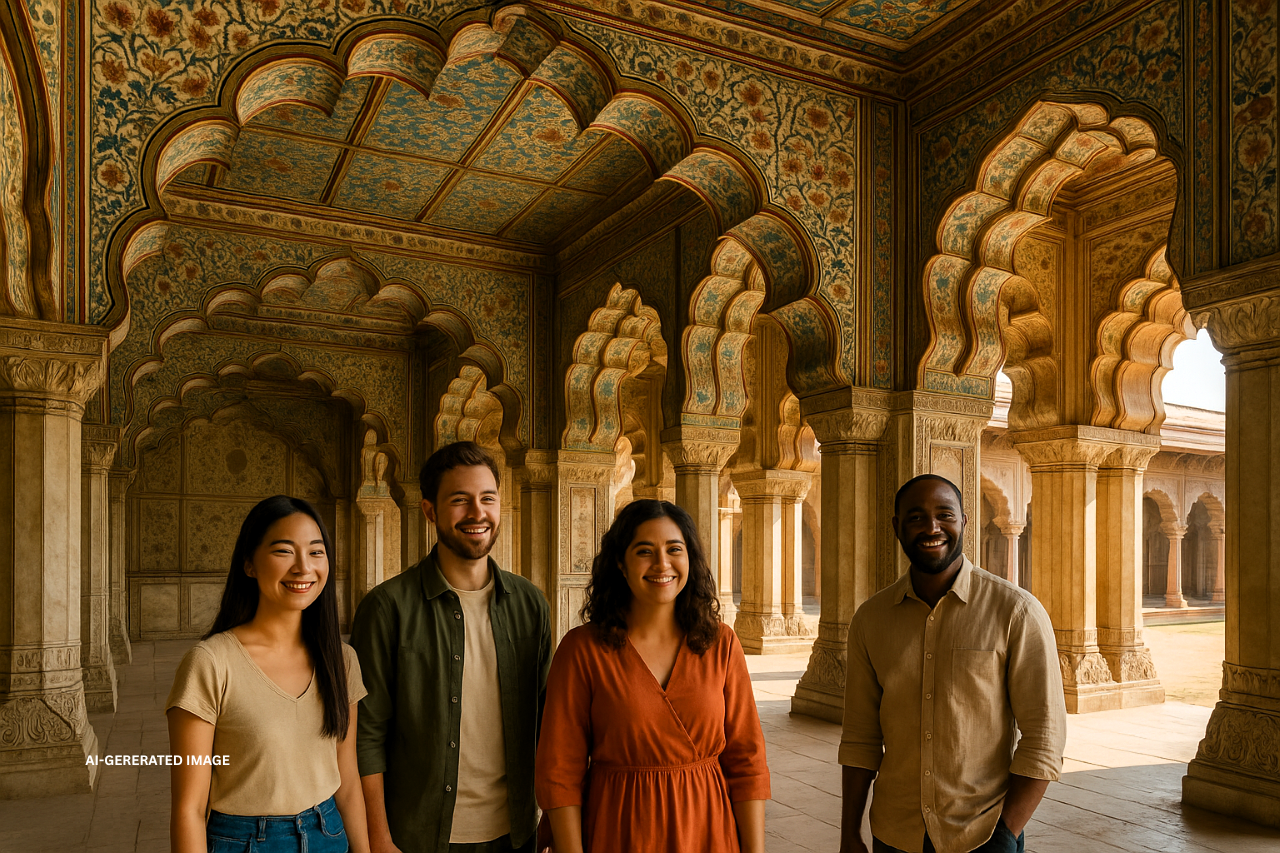
-
Mumtaz Mahal & Khas Mahal:
-
Residential palaces within the fort highlight Mughal elegance in design, featuring marble walls, decorative ceilings, and artistic craftsmanship.
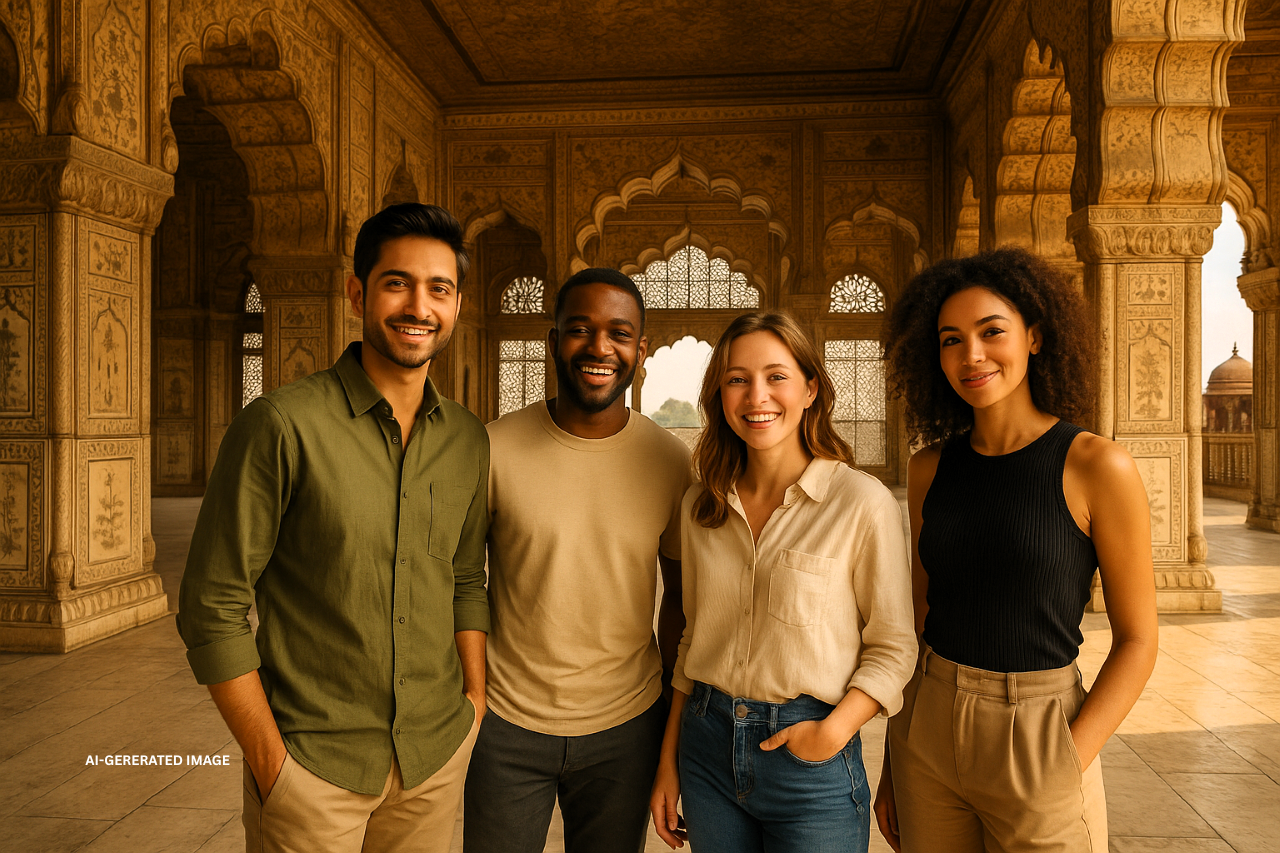
-
Moti Masjid (Pearl Mosque):
-
A small but graceful mosque built by Emperor Aurangzeb for private prayers. Crafted from white marble, it is a serene spiritual space within the fort complex.
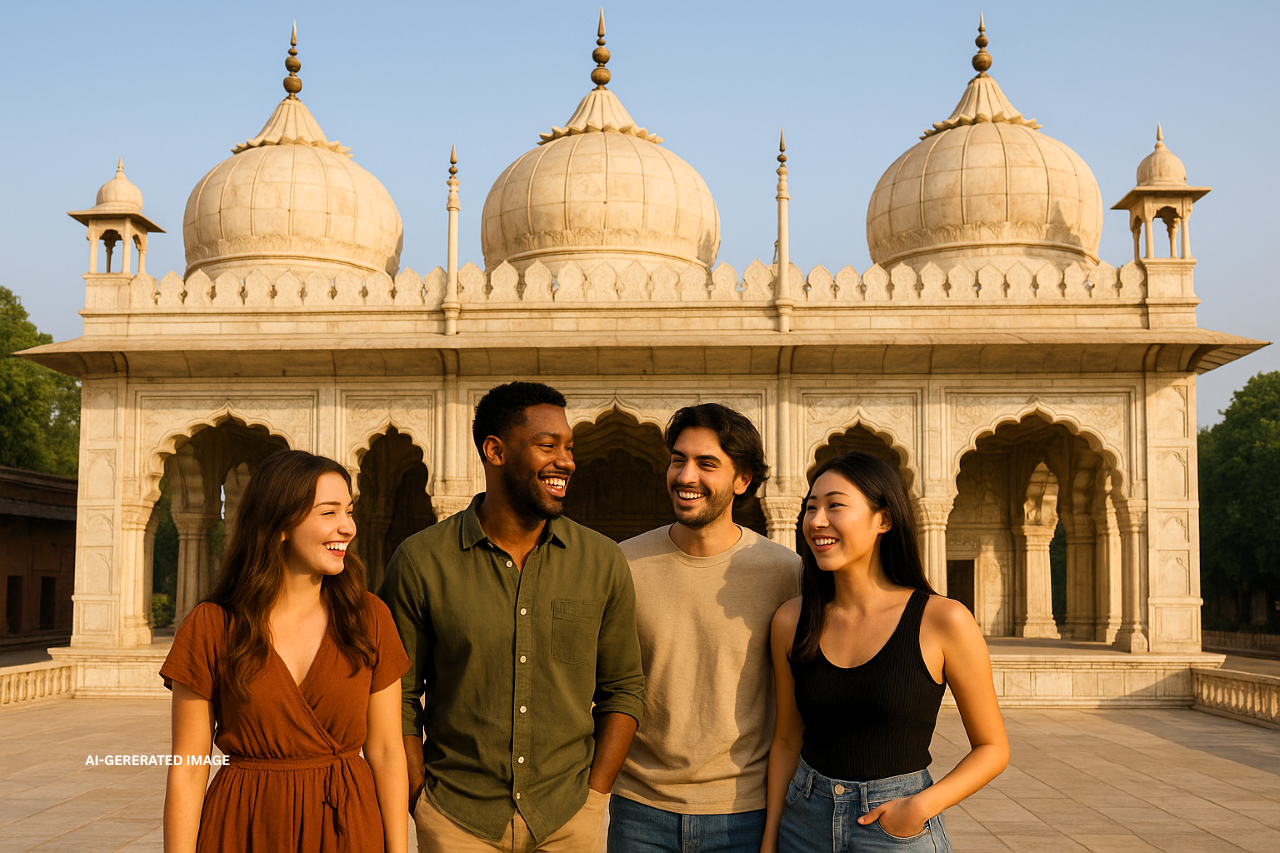
-
Hayat Bakhsh Bagh (Life-Bestowing Garden):
-
A Persian-style garden with fountains and pavilions, designed to bring peace and beauty into the royal residence.
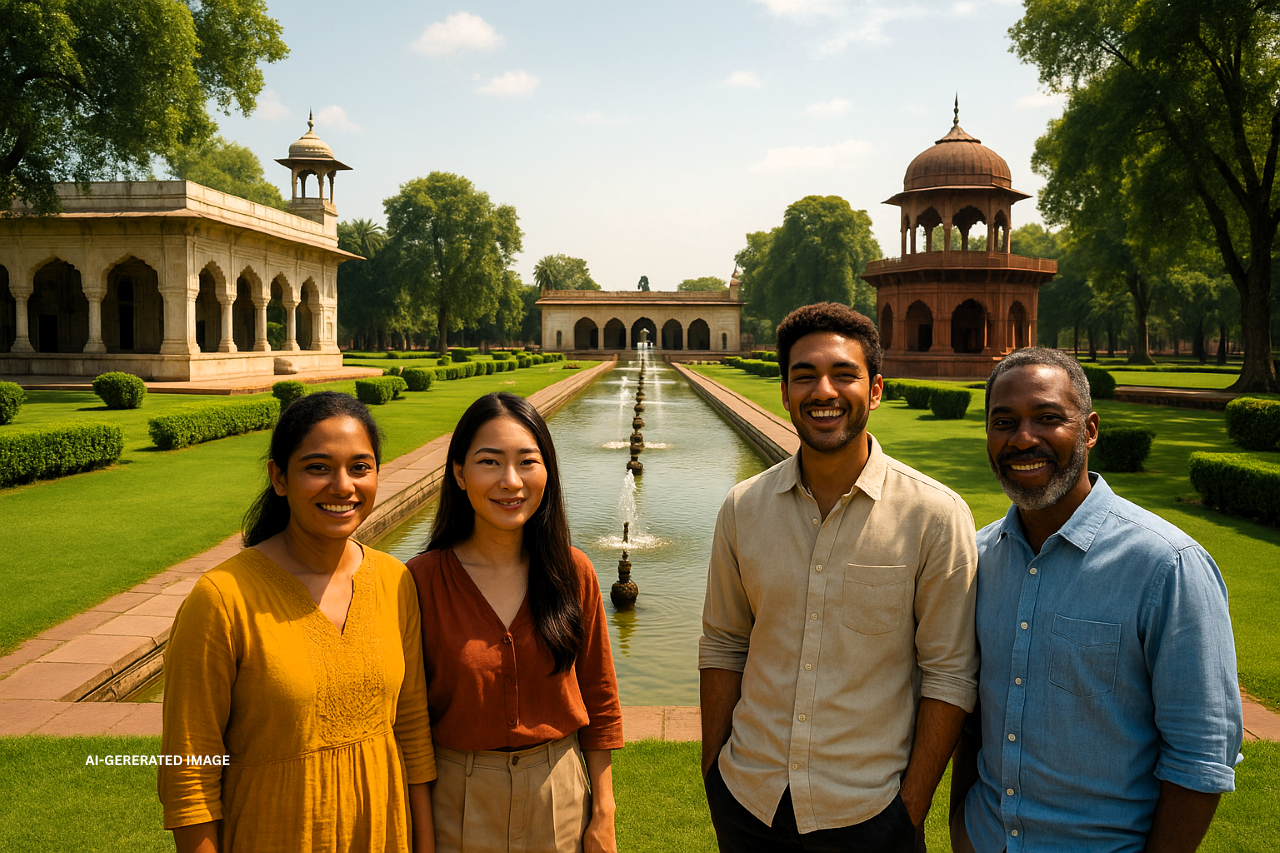
Decorative Art and Craftsmanship
The interiors of the Red Fort in Delhi demonstrate the exquisite artistry of the Mughal Empire. Walls and ceilings were decorated with pietra dura inlay work, semi-precious stone carvings, and delicate floral motifs. Jali (lattice) screens allowed light and air to filter through while adding elegance to the architecture. This fusion of Persian, Timurid, and Indian influences created a style that remains admired to this day.
Red Fort– Symbol of Independence
Though originally built as a royal palace, the Red Fort in Delhi has taken on a much greater symbolic meaning in modern India. On August 15, 1947, the Indian tricolor was hoisted from its ramparts, marking the end of British colonial rule. Prime Minister Jawaharlal Nehru’s historic speech that day gave the fort a new identity as the heart of India’s independence celebrations.
Since then, every year on Independence Day, the Prime Minister continues this tradition by addressing the nation from the fort’s Lahori Gate. This ritual has transformed the Red Fort from a Mughal stronghold into a living monument of freedom, unity, and democracy.
Best Time to Visit the Red Fort
Choosing the right season can greatly enhance your experience at Red Fort Delhi. The fort is open throughout the year, but certain months make sightseeing more comfortable and enjoyable.
-
Winter (November to February):
-
This is the most popular time to visit, as the weather is cool and pleasant. The mild climate allows visitors to comfortably walk through the expansive courtyards, gardens, and palaces. Clear skies also provide excellent lighting for photography.
-
Summer (April to June):
-
Summers in Delhi can be extremely hot, with temperatures rising above 40°C (104°F). If you plan to visit during this season, it’s best to explore the fort in the early morning or late afternoon, when the heat is less intense.
-
Monsoon (July to September):
-
The rains bring relief from the summer heat and give the fort a greener, fresher appearance. However, sudden showers can interrupt sightseeing, so it’s wise to carry an umbrella or raincoat.
👉 Travel Tip: To avoid heavy crowds, plan your visit on a weekday and arrive early in the morning. This gives you time to explore in a more relaxed environment.
Red Fort Visiting Hours & Tickets
Visiting Hours
The Red Fort in Delhi remains open to visitors six days a week.
-
Open Days:
-
Tuesday to Sunday
-
Closed:
-
Mondays
-
Timings:
-
9:30 AM – 4:30 PM (for general entry)
In the evenings, visitors can attend the sound and light show, which has separate timings depending on the season.
Entry Ticket Details
Ticket prices are structured to make the Red Fort accessible for both domestic and international visitors:
-
Indian Citizens:
-
₹35
-
Foreign Tourists:
-
₹500
-
Children below 15 years:
-
Free entry
Tickets can be purchased both online through the official Archaeological Survey of India (ASI) portal and offline at ticket counters near the entrance. Booking online is advisable during peak seasons to avoid long queues.
Light and Sound Show
A major highlight of the fort is the evening sound and light show, which narrates the 350-year history of the Red Fort in Delhi. Using a mix of storytelling, sound effects, and colorful lighting, the show brings alive the tales of Mughal emperors, historic events, and the fort’s role in India’s freedom struggle.
-
Timings:
-
Usually after sunset; exact timings vary by season.
-
Tickets:
-
Sold separately from the main entry ticket and available online or at counters.
Exploring the Red Fort Museum Complex
Inside the Red Fort in Delhi, a cluster of museums adds depth to the visitor experience:
-
Indian War Memorial Museum:
-
Displays weapons, uniforms, and military artifacts from different eras, highlighting India’s martial traditions.
-
Archaeological Museum:
-
Houses coins, manuscripts, pottery, and other Mughal-era relics, offering a glimpse into medieval cultural life.
-
Museum of the 1857 Revolt:
-
Dedicated to India’s first war of independence, this museum preserves documents, maps, and weapons related to the uprising.
Exploring these museums provides a fuller understanding of the fort’s past and allows visitors to connect more deeply with India’s history.
Tips for Visitors – How to Plan Your Visit
A trip to the Red Fort in Delhi becomes more enjoyable when you are well-prepared. Here are some practical tips to help you plan a smooth and memorable visit:
-
Getting There:
-
The easiest way to reach the Red Fort in Delhi is by the Delhi Metro. The nearest stations are Lal Qila Metro Station and Chandni Chowk Metro Station, both within walking distance. Auto-rickshaws, taxis, and buses are also readily available, though the metro is often the fastest option to avoid traffic congestion.
-
Entry Gates:
-
The fort has two main entry points—the Lahori Gate, which serves as the primary entrance, and the Delhi Gate. Security checks are strict, so carrying only essentials will help you move through smoothly.
-
What to Carry and Avoid:
-
Bring essentials like ID proof, a water bottle, sunscreen, and a camera for capturing memories. Avoid carrying prohibited items such as large bags, sharp objects, and drones. If visiting during the summer, pack a cap or hat to stay comfortable in the heat.
-
Time Required:
-
Set aside at least 2–3 hours to explore the fort’s highlights, including the palaces, halls, and museums. If you also wish to attend the evening sound and light show, plan for an additional hour.
Nearby Attractions to Red Fort
The location of the Red Fort in Old Delhi makes it convenient to explore several nearby attractions in a single day:
-
Jama Masjid:
-
One of the largest mosques in India, built by Shah Jahan. Its vast courtyard can hold thousands of worshippers, and the view from its minarets offers a breathtaking glimpse of Old Delhi.
-
Chandni Chowk:
-
A lively marketplace just outside the fort, famous for its food, spices, jewelry, and textiles. From hot jalebis to traditional parathas, it’s a paradise for food lovers and shoppers.
-
Raj Ghat:
-
A serene memorial dedicated to Mahatma Gandhi, located a short distance away. The simplicity of the black marble platform is in stark contrast to the grandeur of the Red Fort in Delhi.
-
Salimgarh Fort:
-
Built before the Red Fort, this historic fort was later integrated into the Mughal complex, offering another glimpse into Delhi’s layered past.
-
Other Cultural Spots:
-
Nearby attractions include the Digambar Jain Temple and the National Gandhi Museum, both worth visiting for their cultural and historical value.
Red Fort in Culture & Cinema
The Red Fort in Delhi is not only an architectural wonder but also a cultural symbol woven into India’s identity.
-
National Celebrations:
-
Every year on Independence Day, millions of people watch the Prime Minister’s address live from the fort’s ramparts. This tradition has made the Red Fort the stage for India’s most important national celebration.
-
Cinema and Media:
-
The fort frequently appears in Bollywood films, documentaries, and international productions as a powerful symbol of India’s history. Its majestic walls and gates have provided a backdrop for countless cinematic moments.
-
Cultural Events:
-
Throughout the year, Red Fort Delhi also hosts exhibitions, fairs, and cultural festivals, showcasing India’s diverse traditions in music, art, and performance. These events make the fort a living cultural hub, not just a historical monument.
Practical Information for Tourists
-
Facilities Inside Red Fort Delhi:
-
Visitors have access to washrooms, drinking water, seating areas, and cloakrooms. Certain parts of the fort are wheelchair accessible.
-
Tour Options:
-
Professional guides are available at the entrance to provide in-depth insights into the fort’s history and architecture. Audio guides and mobile app-based tours are also popular choices for self-guided exploration.
-
Safety Tips:
-
The Red Fort in Delhi can get crowded, especially on weekends and holidays. Keep your belongings safe, stay hydrated, and plan breaks in shaded areas if visiting during the summer. Families with children should plan for extra time to move at a relaxed pace.
Conclusion
The Red Fort Delhi, or Lal Qila, is more than just a historical monument—it is a living emblem of India’s journey through time. From its origins in the Mughal era, when it served as the seat of imperial power, to its modern role as the stage for the Independence Day celebrations, the fort has been at the center of India’s history for centuries. Its grand architecture, cultural importance, and political symbolism make it one of the most significant landmarks in the country.
Walking through its massive gates and exploring its palaces, gardens, and museums is like stepping back into history. Each corner has a story to tell—of emperors, freedom fighters, and the nation’s enduring spirit. For travelers, the Red Fort in Delhi is not simply a place to visit, but an experience that connects them with India’s soul.
FAQs
When was the Red Fort in Delhi built?
Construction began in 1638 and was completed in 1648, during the reign of Mughal Emperor Shah Jahan.
Who built the Red Fort in Delhi?
The fort was commissioned by Shah Jahan and designed by Ustad Ahmad Lahauri, the same architect who created the Taj Mahal.
Why is the Red Fort called Lal Qila?
It is called Lal Qila because of its striking red sandstone walls, which give the fort its unique appearance.
What is the best time to visit the Red Fort?
The winter season (November to February) is the most comfortable and ideal time to explore the fort.
How much are Red Fort tickets?
-
Indians:
-
₹35
-
Foreigners:
-
₹500
-
Children under 15:
-
Free entry
What are the Red Fort visiting hours?
The fort is open from 9:30 AM to 4:30 PM, Tuesday to Sunday. It remains closed on Mondays.
Why is the Red Fort in Delhi important in Indian history?
It served as the seat of Mughal power for nearly 200 years and later became a symbol of India’s independence when the national flag was hoisted here in 1947.
How long does it take to explore the Red Fort complex?
On average, it takes 2–3 hours to explore the fort and museums. If you include the sound and light show, plan for around 4 hours.
Can foreigners buy Red Fort tickets online?
Yes, foreign visitors can book tickets online through the official Archaeological Survey of India (ASI) website or other authorized booking portals.
What is the sound and light show at the Red Fort?
It is an evening multimedia show that narrates the fort’s history using sound effects, lights, and narration. It highlights the grandeur of the Mughal Empire and the fort’s role in India’s freedom struggle.
